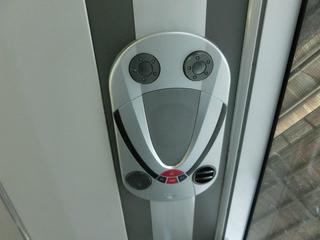Strictly speaking Pelni have nothing to do with the sea route between (Davao) General Santos and Bitung in Surawesi.
However, this route is often talked about in the margins of Pelni sea routes, hence above title.
Wether or not this General Santos-Bitung sea route is open is of greatest interest to many around the world. I therefore flew from Tokyo to General Santos on 26 and 27 July 2016 to put an end to endless enquries on the net. My discovery is that it is closed now.
What I did was as follows.
1. I visited (or tried to visit) the EPA office in the pier area of General Santos.

This above photo is the gate to the pier area. It is currently being reformed as you can see from the scaffolds. Unlike in Japan you cannot enter the pier area in the Philippines without authorisation and this was as far as I could get to.
In the photo my tricycle driver is talking to the gate personnel about EPA. His discovery was that EPA in this pier no longer existed and that they did not know where EPA is currently located.
So, I asked my tricycle driver to telephone their office, but the line was dead.
We are told at the gate that along the western coast of General Santos over the distance of some 10km there are shipping companies which we might visit and talk to and we were given the names.
2. I therefore visited and talked to 2 companies away from the pier area who might be offering passenger shipping service from General Santos to Bitung. As it turned out they were not shipping companies, but fishing companies.
Their answers were equally negative. The first one (no photo), furthest from the pier, was only a pure fishing compnay (tuna fishing for export to Japan) with no interest whatsoever in ferrying service.
With the second one I discovered that they do ferry people to Bitung, but only their company employees who are engaged in sending out their tunas from the airport of Manado to Japan.

 In fact, this area was dedicated to tuna fishing as you can see from this tuna figure in above photo. Apparenty, more than 90% of the tunas are exported to Japan to turn them into sushi.
In fact, this area was dedicated to tuna fishing as you can see from this tuna figure in above photo. Apparenty, more than 90% of the tunas are exported to Japan to turn them into sushi.
3. I visited the main tourist office in the centre of General Santos and talked to its Head direct.
 Tourist ofice area in General Santos.
Tourist ofice area in General Santos.
He said :
3.1 EPA still exists somewhere, but not in General Santos any more.
3.2 EPA stopped their ferrying service 2 or 3 years ago because there had not been enough demand.
3.3 However, JICA (Japan International Cooperation Agency), at the request of the Philippine government, had made surveys and their advice was the reopening of the route (Davao-General Santos-Bitung).
The route was to have been opened last year, but it was postponed due to the presidential election of May this year (2016).
3.4 Cebu Pacific flies Davao to Jakarta.
This air route could be used, I think, in relation to the Pelni service, albeit in a limited way, by making Jakarta starting and finishing ports. Then fly Davao, then fly Mactan, Cebu and then fly direct back to Narita (Tokyo).
If Cebu Pacific do this Davao-Jakarta their Indonesian counterparts must be doing something similar, and if they do Manado (or Menado, some times) to somewhere in the Philippines that will be great.
So, my quick visit to General Santos was worth it. Currently, there is no ferrying service between General Santos and Bitung.
If you do not like the noise of Jakarta the only realistic way to have a go at Pelni now must be via Zamboanga-Sandakan-Tawau-Nunukan-Tarakan, and Makassaru.
For your information (expecting it to be useful when the route is resumed) the best and easiest way to travel from Davao to General Santos (Gensan, locally) is by the Yellow Bus from the Overland Transport Terminal.

The hotel I used was Casa Leticia Business Inn and the terminal is a few minutes form the hotel. The taxi from Davao International was PHP 218. This hotel is OK, but not for
backpackers. 
In Gensan I stayed at Columbus Plaza Hotel. It was superb. By far the best hotel amongst 20 odd hotels I experienced in the Philippines, except those 5 stars in Manila.
This bus terminal is large and is clearly layed out.
 The buses are superb and modern
The buses are superb and modern
with a toilet. 
The bus is fully airconditioned. 
Venders come in and they will disemabark before the bus leaves the terminal.

In Gensan itself there is a similar busterminal (slightly smaller, but equally efficient).
In fact, I realised at the Gensan bus terminal that some of the buses are equipped with WIFI (not all) as you can see below.
 (Free WIFI)
(Free WIFI)
 (No WIFI)
(No WIFI)
It takes just over three hours, with most of the route along the southern coast of Davao, and the last one hour in hills. One way fare is PHP 190.
You cannot use a taxi from Davao to Gensan as taxis are not allowed to do that. On the following day I used a taxi from Davao to Tugm, about the same temporal distance and that was PHP 1,000, just for your information.









